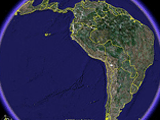Beijing's Latin America inroads
By Samuel Logan for ISN
The Bank of China will open its first office in Brazil in March 2009, marking Brazil's importance to China in growing Sino-Latin American relations, according to a 28 November report in China's official newspaper, the China Daily.
The results of the recently concluded Asian-Pacific Economic Council (APEC) summit in Lima, Peru, show that Brazil is not the only country important for China in Latin America. In fact, compared to the 2004 APEC summit held in Santiago, Chile, China's growing presence in Latin America shows a determined, focused and well planned approach centered on trade, political ties and Chinese energy security.
In 2004, Chinese leader Hu Jintao made a very public tour of Latin America, promising US$100 billion in trade by 2010 on the heels of the APEC summit in Chile. His promise was reached in 2007, with trade between China and Latin America passing some US$102 billion and bilateral trade between China and Brazil around US$23.37 billion, according to China's Ministry of Development, Industry and Foreign Trade (MDIC).
China has inked a free trade agreement (FTA) with Chile and Peru, and negotiations for an FTA with Costa Rica are underway.
Traveling to Cuba and Costa Rica before the APEC summit, Hu brought with him an entourage of 12 Chinese ministers and some 600 business leaders. Compared to the relatively small group accompanying him in 2004, the size of this new group indicated a strong Chinese interest in Latin American business opportunities. Likewise, the large number of ministers present indicated China's focus on reaching beyond trade and into politics.
In a speech before the Peruvian Congress, Hu said China and Latin America should first maintain high-level exchanges and contacts, but this is nothing new: Political ties in Latin America, however, have been a Chinese policy for over a decade.
In the 1990s, China became an observer to the Organization of American States (OAS). In 2004, China was granted observer status at the Latin American parliament in Brasilia, Brazil. In December of that year, the Chinese Communist Party announced it was working to develop party-to-party relations with Venezuelan President Hugo Chavez's Movement of the 5th Republic party.
In August 2006, the Chinese Communist Party signed a memorandum of understanding with the Brazilian congressional lower house to establish what it called a "regular exchange mechanism."
The 2008 APEC summit was Hu's second visit to the region, but many Latin American heads of state have made the pilgrimage to China, with Chavez leading the way, visiting China in 1999, 2001, 2004, 2006 and this year. Chilean President Michelle Bachelet visited China in April of this year, and Ecuadorian President Rafael Correa in November 2007. Brazilian President Luis Inacio Lula da Silva visited the country in 2004.
Beyond growing trade and political ties, perhaps the most significant development between the 2004 and 2008 APEC summits is how China has grown beyond its resource diplomacy stance into what many in the region now consider a new patron state.
It is a leadership role solidified by China's new seat on the board table of the Inter-American Development Bank, guaranteed by a US$350 million investment.
From 2004, moving forward, observers watched China secure raw materials through investing in Chinese businesses that operated in Latin America. After the honeymoon period in late 2004, when many Latin American business leaders thought they could look forward to a sharp increase in Chinese foreign direct investment, many were disillusioned by the fact that the Chinese did not invest in their companies. They bought them, or hired local lawyers to help them navigate the often-complicated world of conducting business in Latin America. There were some exceptions, such as Chile's Codelco copper mining company, which saw a significant investment from China, but the general feeling was one of concern.
When China purchased Argentina's only iron-ore mine, observers in Buenos Aires were surprised to learn that Argentines were not given the resulting jobs. Chinese laborers were brought over to do the work. When China offered to make a US$4.82 billion investment in Brazil's rail lines, the deal stalled because China wanted to bring in its own workers, while the Brazilian government wanted those jobs for Brazilians.
Brazil's ire deepened further when it saw a flip in its trade balance with China, resulting in a deficit largely driven by cheap Chinese textiles flooding Brazilian markets. Some business sectors thought the Chinese might have been "dumping" textiles on Brazil, selling them at prices far below market prices. Similar concerns hover in Peru, where the government may seek provisions with in its new FTA with China to protect its own textile sector.
Overall, however, the Sino-Latin American relationship appears to be positive. With China's increased interest in the region, and expansion into a number of markets beyond just energy-related purchases of raw materials, the region may well benefit from its growing relationship with China.
Countries that replace a dependence on trade with the US with a dependence on China, however, should be aware of China's own economic troubles, banking sector weaknesses, and ultimately the Communist Party's sense of self preservation. Hu Jintao said that China would be a friend for Latin America in good times and bad. As the financial crisis deepens, it will be a test to see how far China will go to translate words into action.

